Performance Analysis of a Waste-Gated Turbine for Automotive Engines: An Experimental and Numerical Study
Abstract
1. Introduction
2. Experimental Activity
2.1. Test Bench Setup and Measuring Equipment
2.2. Experimental Results
- Turbine rotational speed factor [rpm/√K].
- Total-to-static expansion ratio [-]
- Turbine mass flow rate factor [(kg·√K)/(s·bar)]
- Waste-gate mass flow rate factor [(kg·√K)/(s·bar)]
- Turbine isentropic efficiency [-]
- Turbocharger mechanical efficiency [-]
- Turbine thermomechanical efficiency [-]
3. One-Dimensional Model
4. Conclusions
Author Contributions
Funding
Data Availability Statement
Conflicts of Interest
Nomenclature
| Acronyms | |
| 1D | One-dimensional |
| BSFC | Brake-Specific Fuel Consumption |
| CNG | Compressed Natural Gas |
| CO2 | Carbon Dioxide |
| FS | Full Scale |
| MV | Measured Value |
| NOx | Nitrogen Oxides |
| Notations | |
| A | Area, [m2] |
| Discharge coefficient, [-] | |
| Specific heat at constant pressure, [J/(kg·K)] | |
| k | Heat capacity ratio |
| M | Mass Flow Rate, [kg/s] |
| N | Rotational speed factor, [rpm/√K] |
| n | Rotational speed, [rpm] |
| P | Power, [W] |
| p | Pressure, [bar] |
| T | Temperature, [K] |
| u | Velocity, [m/s] |
| WG | Waste-gate |
| ε | Expansion ratio, [-] |
| η | Efficiency, [-] |
| Φ | Mass flow rate factor, [(kg·K)/(s·bar)] |
| Density, [kg/m3] | |
| Subscripts and Superscripts | |
| 3 | Turbine inlet |
| 4 | Turbine outlet |
| c | Compressor |
| eff | Effective |
| is | Isentropic |
| m | Mechanical |
| pm | Mechanical losses |
| ref | Reference |
| S | Static condition |
| T | Total condition |
| t | Turbine |
| TC | Turbocharger |
| wg | Waste-gate valve |
| ‘ | Thermomechanical |
| * | Normalized value |
References
- Möring-Martínez, G.; Senzeybek, M.; Jochem, P. Clustering the European Union electric vehicle markets: A scenario analysis until 2035. Transp. Res. Part D Transp. Environ. 2024, 135, 104372. [Google Scholar] [CrossRef]
- Molina, S.; Novella, R.; Gomez-Soriano, J.; Olcina-Girona, M. Impact of medium-pressure direct injection in a spark-ignition engine fueled by hydrogen. Fuel 2024, 360, 130618. [Google Scholar] [CrossRef]
- ACEA. Vehicles in Use Europe 2022; ACEA: Brussels, Belgium, 2022. [Google Scholar]
- European Green Deal n.d. Available online: https://ec.europa.eu/clima/eu-action/european-greendeal_en (accessed on 17 March 2022).
- Samaras, Z.C.; Kontses, A.; Dimaratos, A.; Kontses, D.; Balazs, A.; Hausberger, S.; Ntziachristos, L.; Andersson, J.; Ligterink, N.; Aakko-Saksa, P.; et al. A European Regulatory Perspective towards a Euro 7 Proposal. SAE Int. J. Adv. Curr. Pract. Mobil. 2022, 5, 998–1011. [Google Scholar] [CrossRef]
- Di Blasio, G.; Ianniello, R.; Beatrice, C.; Pesce, F.; Vassallo, A.; Belgiorno, G. Additive manufacturing new piston design and injection strategies for highly efficient and ultra-low emissions combustion in view of 2030 targets. Fuel 2023, 346, 128270. [Google Scholar] [CrossRef]
- Molden, N. Innovative Emissions Measurement and Perspective on Future Tailpipe Regulation Real-world measurement and role of VOCs and N2O emissions. Johns. Matthey Technol. Rev. 2023, 67, 130–137. [Google Scholar] [CrossRef]
- Onorati, A.; Payri, R.; Vaglieco, B.M.; Agarwal, A.; Bae, C.; Bruneaux, G.; Canakci, M.; Gavaises, M.; Günthner, M.; Hasse, C.; et al. The role of hydrogen for future internal combustion engines. Int. J. Engine Res. 2022, 23, 529–540. [Google Scholar] [CrossRef]
- Misul, D.A.; Scopelliti, A.; Baratta, M. High-Performance Hydrogen-Fueled Internal Combustion Engines: Feasibility Study and Optimization via 1D-CFD Modeling. Energies 2024, 17, 1593. [Google Scholar] [CrossRef]
- de Lima, A.J.T.B.; Gallo, W.L.R. Investigations on energy efficiency enhancement under knock threshold limit conditions for a turbocharged direct-injection spark-ignition engine fueled with wet ethanol. Appl. Therm. Eng. 2023, 232, 121003. [Google Scholar] [CrossRef]
- Brin, J.; Waldron, T. Hydrogen Engine Testing with SuperTurbo Compared to Simulation; SAE Technical Paper 2024-01-2087; SAE International: Warrendale, PA, USA, 2024. [Google Scholar] [CrossRef]
- Andrisani, N.; Bagal, N. Benefits of Supercharger Boosting on H2 ICE for Heavy Duty Applications; SAE Technical Paper 2024-01-3006; SAE International: Warrendale, PA, USA, 2024. [Google Scholar] [CrossRef]
- Lai, F.Y.; Sun, B.G.; Xiao, G.; Luo, Q.H.; Bao, L.Z. Research on optimizing turbo-matching of a large-displacement PFI hydrogen engine to achieve high-power performance. Int. J. Hydrogen Energy 2023, 48, 38508–38520. [Google Scholar] [CrossRef]
- Usai, V.; Marelli, S. Evaluation of the transient performance of a two-stage hybrid boosting system for spark ignition engines. Proc. Inst. Mech. Eng. Part D J. Automob. Eng. 2023, 09544070231209082. [Google Scholar] [CrossRef]
- Stoffels, H.; Quiring, S.; Pingen, B. Analysis of transient operation of turbo charged engines. SAE Int. J. Engines 2010, 3, 438–447. [Google Scholar] [CrossRef]
- Tang, Q.; Fu, J.; Liu, J.; Boulet, B.; Tan, L.; Zhao, Z. Comparison and analysis of the effects of various improved turbocharging approaches on gasoline engine transient performances. Appl. Therm. Eng. 2016, 93, 797–812. [Google Scholar] [CrossRef]
- Galindo, J.; Serrano, J.R.; De la Morena, J.; Gómez-Vilanova, A. Physical-based variable geometry turbines predictive control to enhance new hybrid powertrains’ transient response. Energy 2022, 261, 125189. [Google Scholar] [CrossRef]
- Ismail, M.I.; Costall, A.; Martinez-Botas, R.; Rajoo, S. Turbocharger Matching Method for Reducing Residual Concentration in a Turbocharged Gasoline Engine; SAE Technical Papers 2007-01-0381; SAE International: Warrendale, PA, USA, 2015. [Google Scholar] [CrossRef]
- Bozza, F.; Gimelli, A.; Strazzullo, L.; Torella, E.; Cascone, C. Steady-State and Transient Operation Simulation of a “Downsized” Turbocharged SI Engine; SAE Technical Paper 2007-01-0381; SAE International: Warrendale, PA, USA, 2007. [Google Scholar] [CrossRef]
- Capobianco, M.; Marelli, S. Waste-Gate Turbocharging Control in Automotive SI Engines: Effect on Steady and Unsteady Turbine Performance; SAE Technical Papers 2007-01-3543; SAE International: Warrendale, PA, USA, 2007. [Google Scholar] [CrossRef]
- Serrano, J.R.; Arnau, F.J.; Andrés, T.; Samala, V. Experimental procedure for the characterization of turbocharger’s waste-gate discharge coefficient. Adv. Mech. Eng. 2017, 9, 1687814017728242. [Google Scholar] [CrossRef]
- Capobianco, M.; Marelli, S. Experimental analysis of unsteady flow performance in an automotive turbocharger turbine fitted with a waste-gate valve. Proc. Inst. Mech. Eng. Part D J. Automob. Eng. 2011, 225, 1087–1097. [Google Scholar] [CrossRef]
- Deng, Q.; Burke, R.D.; Zhang, Q.; Pohorelsky, L. A Research on Waste-Gated Turbine Performance Under Unsteady Flow Condition. In Proceedings of the ASME Turbo Expo 2016: Turbomachinery Technical Conference and Exposition, Seoul, Republic of Korea, 13–17 June 2016. [Google Scholar] [CrossRef]
- Ghazikhani, M.; Davarpanah, M.; Mousavi Shaegh, S.A. An experimental study on the effects of different opening ranges of waste-gate on the exhaust soot emission of a turbo-charged DI diesel engine. Energy Convers. Manag. 2008, 49, 2563–2569. [Google Scholar] [CrossRef]
- Kharazmi, S.; Hajilouy-Benisi, A.; Mozafari, A. Experimental Investigation of Waste Gate Effects on Performance and NOx Emissions in a Turbocharged Aftercooled CNG SI Engine and its Turbocharger; SAE Technical Paper 2015-01-1957; SAE International: Warrendale, PA, USA, 2015. [Google Scholar] [CrossRef]
- Serrano, J.R.; Arnau, F.J.; Novella, R.; Reyes-Belmonte, M.A. A Procedure to Achieve 1D Predictive Modeling of Turbochargers under Hot and Pulsating Flow Conditions at the Turbine Inlet; SAE Technical Paper 2014-01-1080; SAE International: Warrendale, PA, USA, 2014. [Google Scholar] [CrossRef]
- De Bellis, V.; Bozza, F.; Marelli, S.; Capobianco, M. Advanced Numerical/Experimental Methods for the Analysis of a Waste-Gated Turbocharger Turbine. SAE Int. J. Engines 2014, 7, 145–155. [Google Scholar] [CrossRef]
- Gamma Technologies Inc. GT-Power User’s Manual and Tutorial, GT Suite; Gamma Technologies Inc.: Westmont, IL, USA, 2022. [Google Scholar]
- Ketata, A.; Driss, Z.; Abid, M.S. Impact of the wastegate opening on radial turbine performance under steady and pulsating flow conditions. Proc. Inst. Mech. Eng. Part D J. Automob. Eng. 2020, 234, 652–668. [Google Scholar] [CrossRef]
- Salehi, R.; Vossoughi, G.; Alasty, A. Modeling and Estimation of Unmeasured Variables in a Wastegate Operated Turbocharger. J. Eng. Gas Turbines Power 2014, 136, 052601. [Google Scholar] [CrossRef]
- Cordalonga, C.; Usai, V.; Marelli, S. Experimental and numerical analysis of a waste-gated turbine for automotive turbocharged engine. J. Phys. Conf. Ser. 2024, 2893, 012098. [Google Scholar] [CrossRef]
- Usai, V.; Marelli, S. Steady state experimental characterization of a twin entry turbine under different admission conditions. Energies 2021, 14, 2228. [Google Scholar] [CrossRef]
- Aghaali, H.; Ångström, H.E. Turbocharged si-engine simulation with cold and hot-measured turbocharger performance maps. In Proceedings of the ASME Turbo Expo 2012: Turbine Technical Conference and Exposition, Copenhagen, Denmark, 11–15 June 2012. [Google Scholar] [CrossRef]
- Chung, J.E.; Chung, J.; Kim, N.H.; Lee, S.W.; Kim, G.Y. An investigation on the efficiency correction method of the turbocharger at low speed. Energies 2018, 11, 269. [Google Scholar] [CrossRef]
- Toussaint, L.; Marques, M.; Morand, N.; Davies, P.; Groves, C.; Tomanec, F.; Zatko, M.; Vlachy, D.; Mrazek, R. Improvement of a turbocharger by-pass valve and impact on performance, controllability, noise and durability. In Proceedings of the Institution of Mechanical Engineers—11th International Conference on Turbochargers and Turbocharging, London, UK, 13–14 May 2014. [Google Scholar] [CrossRef]
- Zimmermann, R.; Baar, R.; Biet, C. Determination of the isentropic turbine efficiency due to adiabatic measurements and the validation of the conditions via a new criterion. Proc. Inst. Mech. Eng. Part C J. Mech. Eng. Sci. 2018, 232, 4485–4494. [Google Scholar] [CrossRef]
- Zhihui, W.; Chaochen, M.; Nian, J. Temperature measurement at turbine outlet achieved by a sensing net and infrared thermometry method. Int. J. Therm. Sci. 2024, 196, 108706. [Google Scholar] [CrossRef]
- Cordalonga, C.; Marelli, S.; Usai, V.; Capobianco, M. Indirect Assessment of Isentropic Efficiency in Turbocharger Turbines via Mechanical Efficiency Evaluation under Quasi-Adiabatic Test; SAE Technical Papers 2023-24-0121; SAE International: Warrendale, PA, USA, 2023. [Google Scholar] [CrossRef]
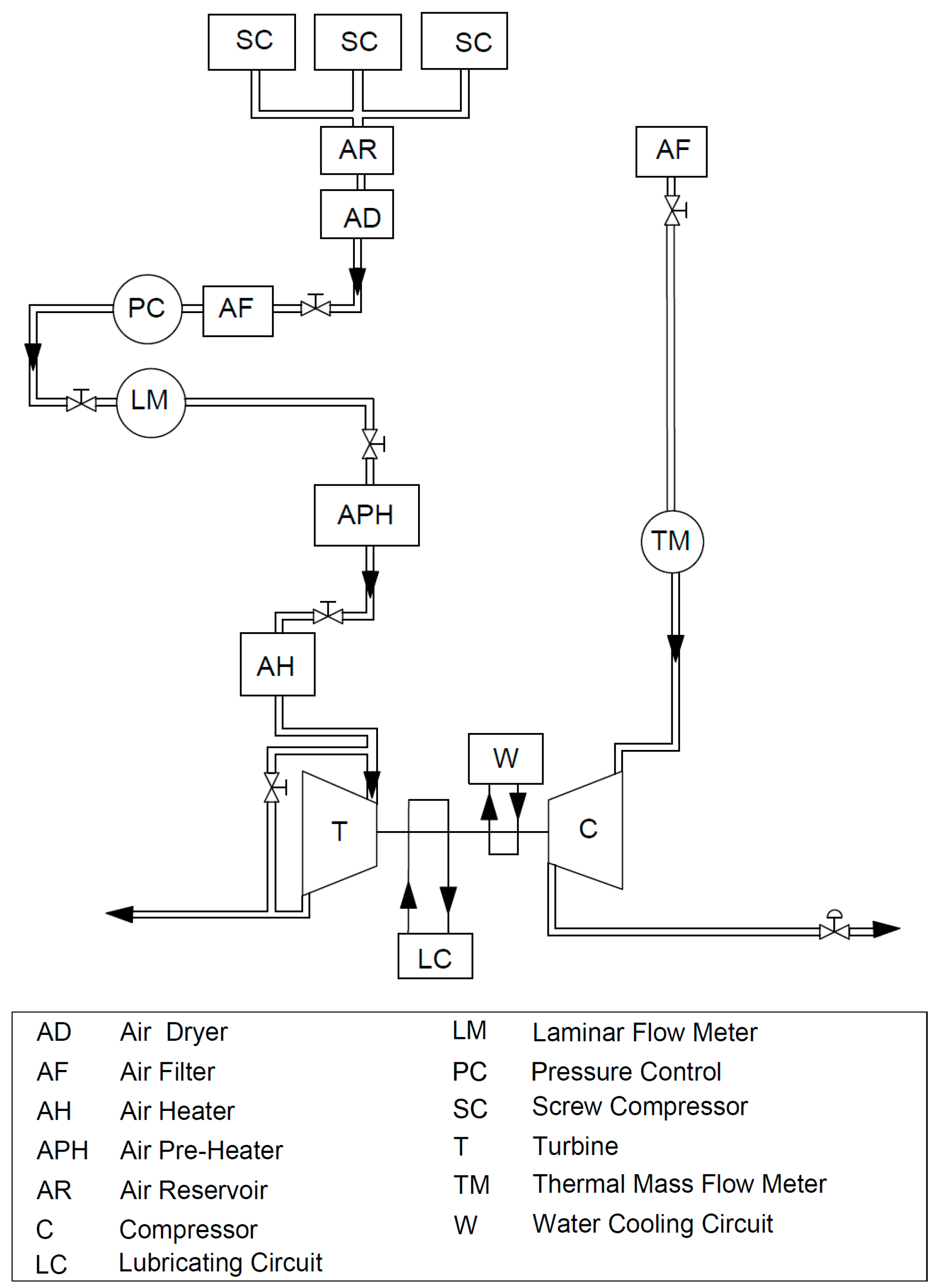
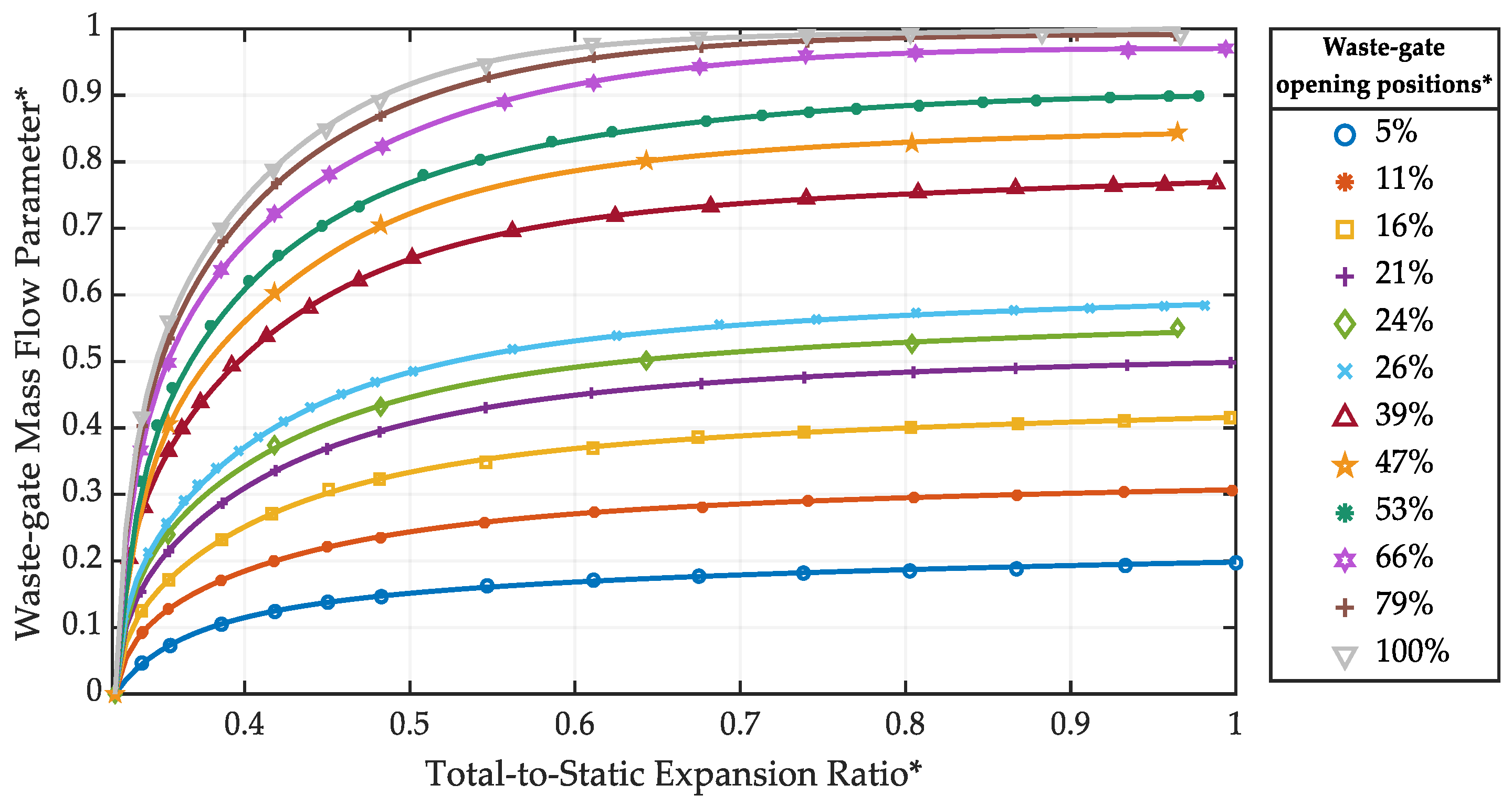
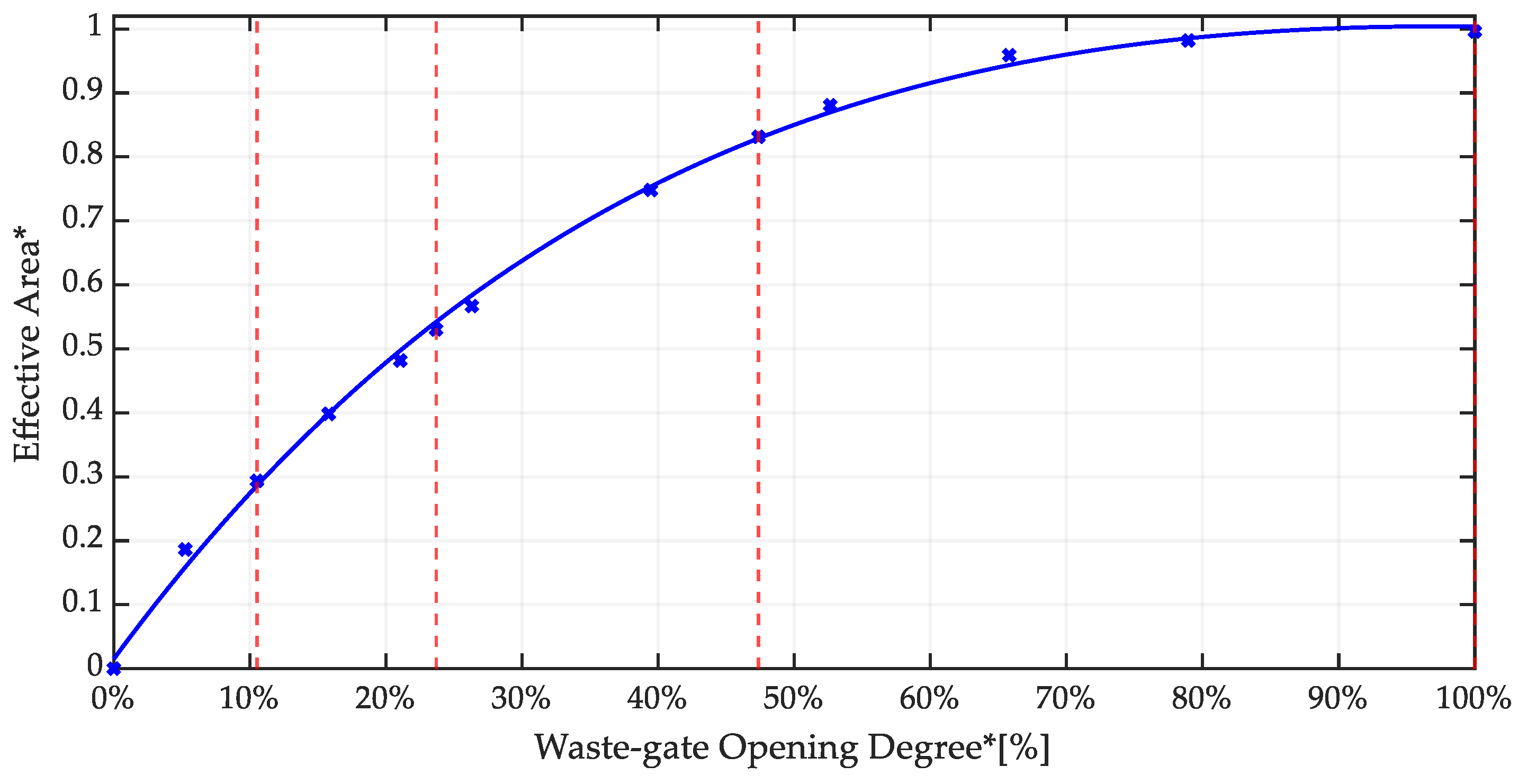


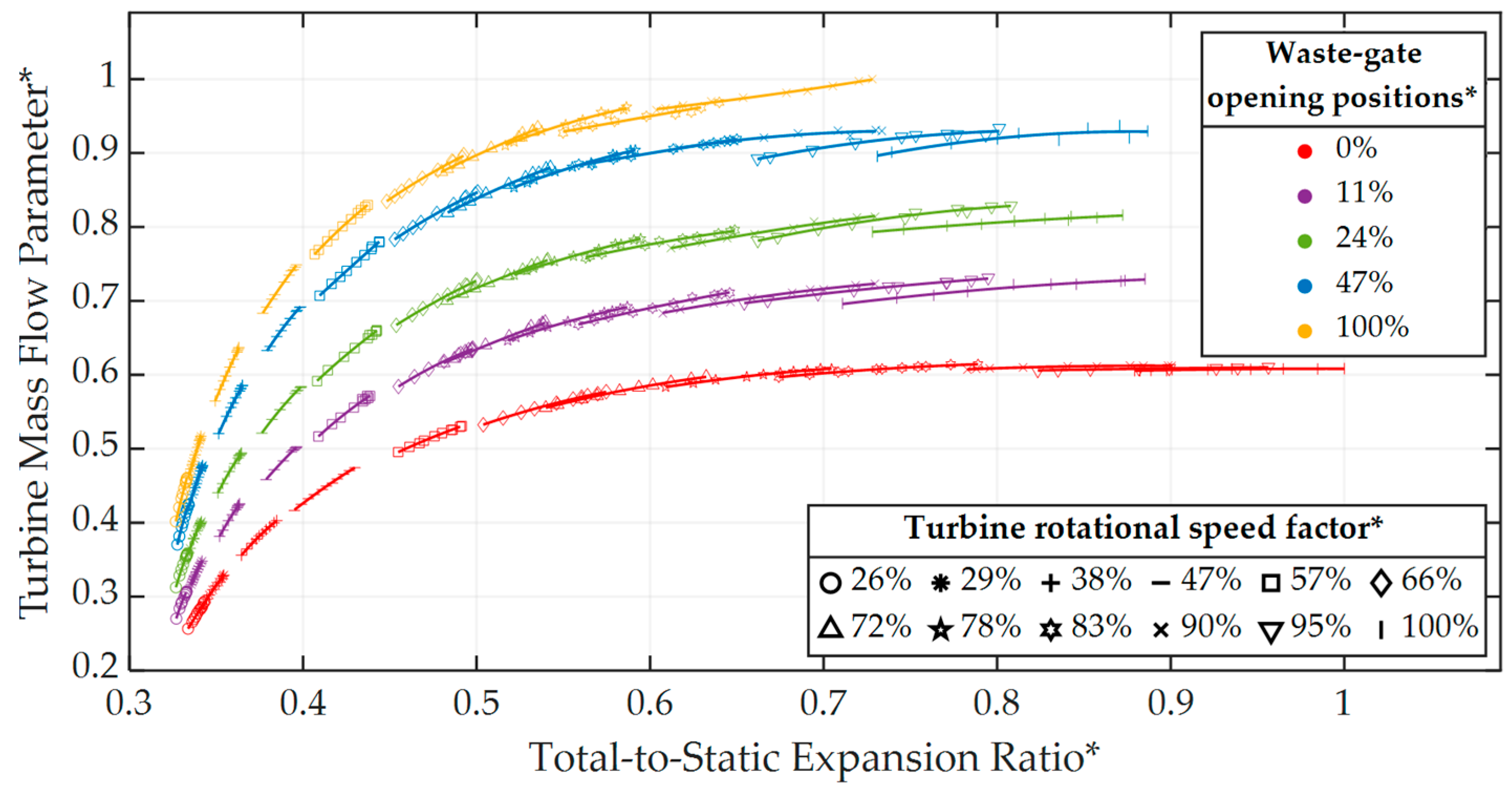
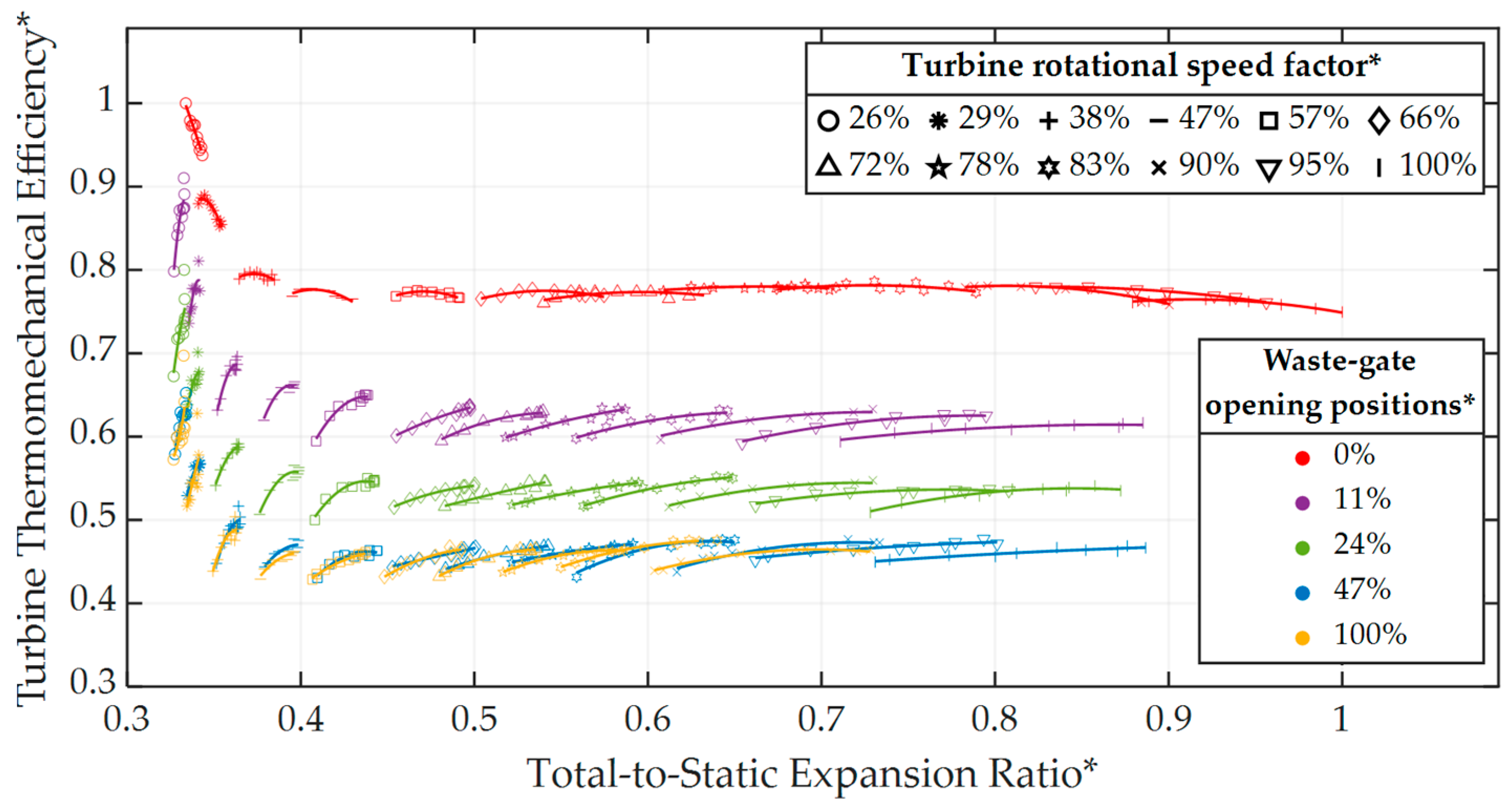
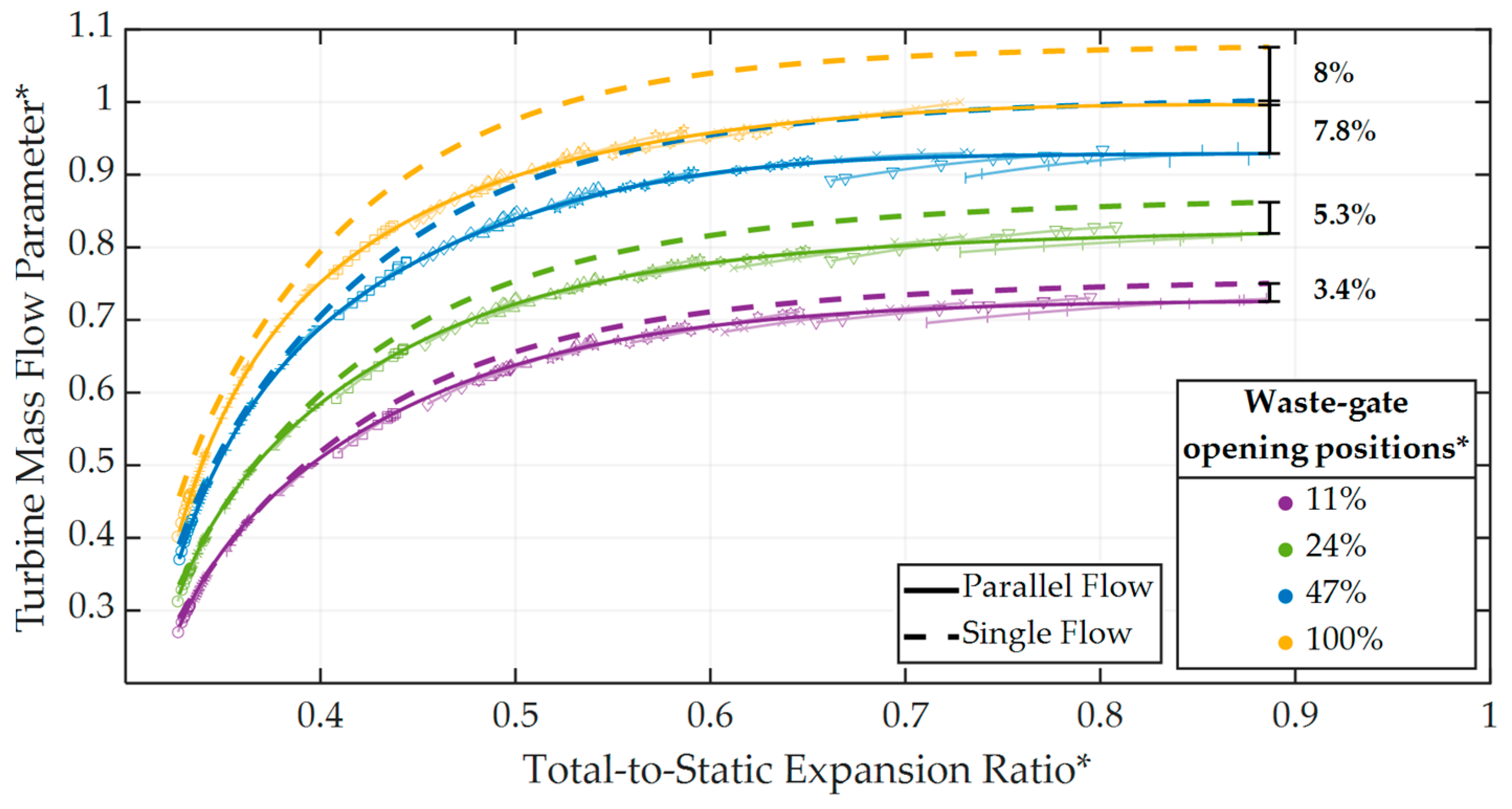
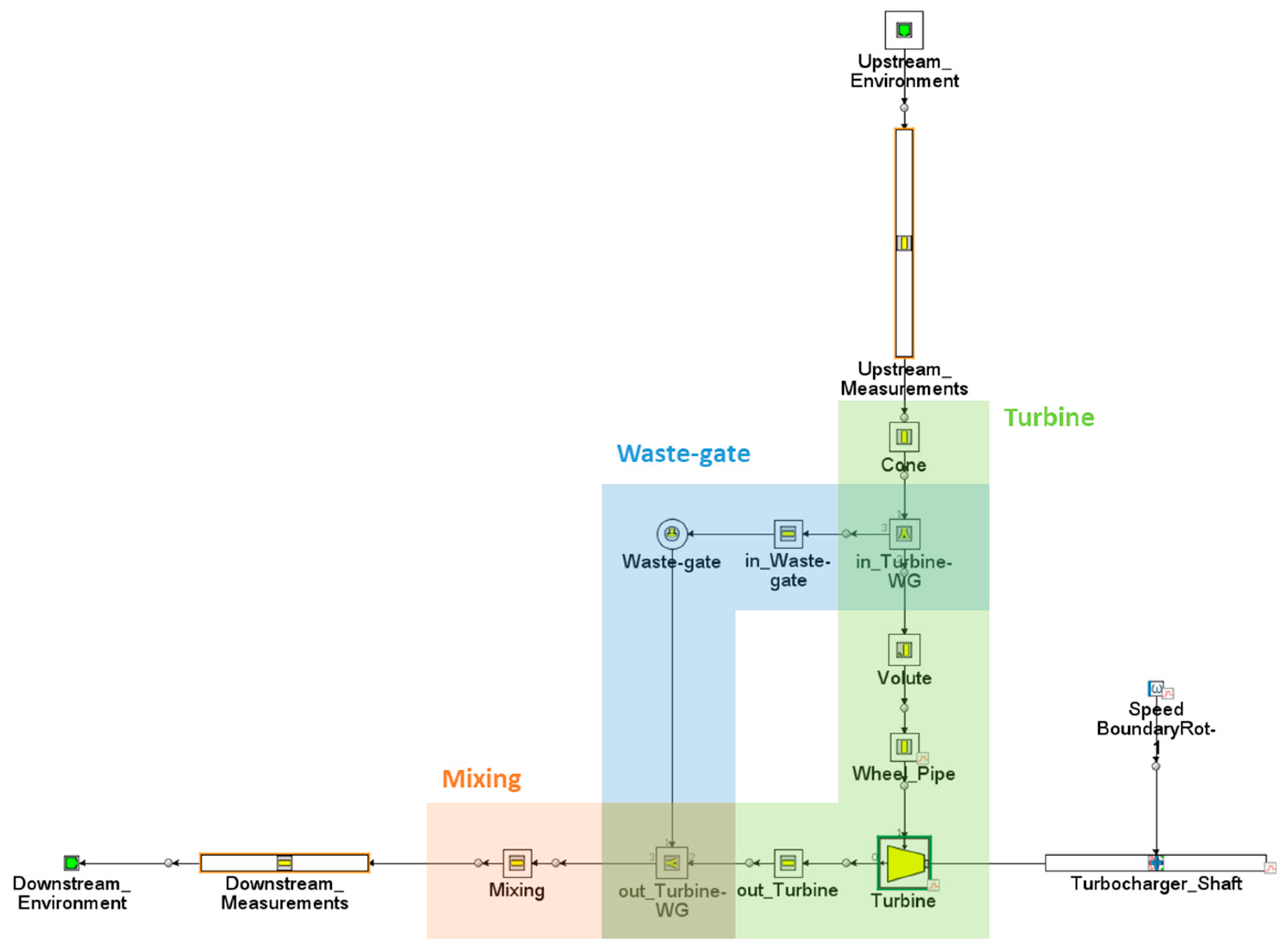
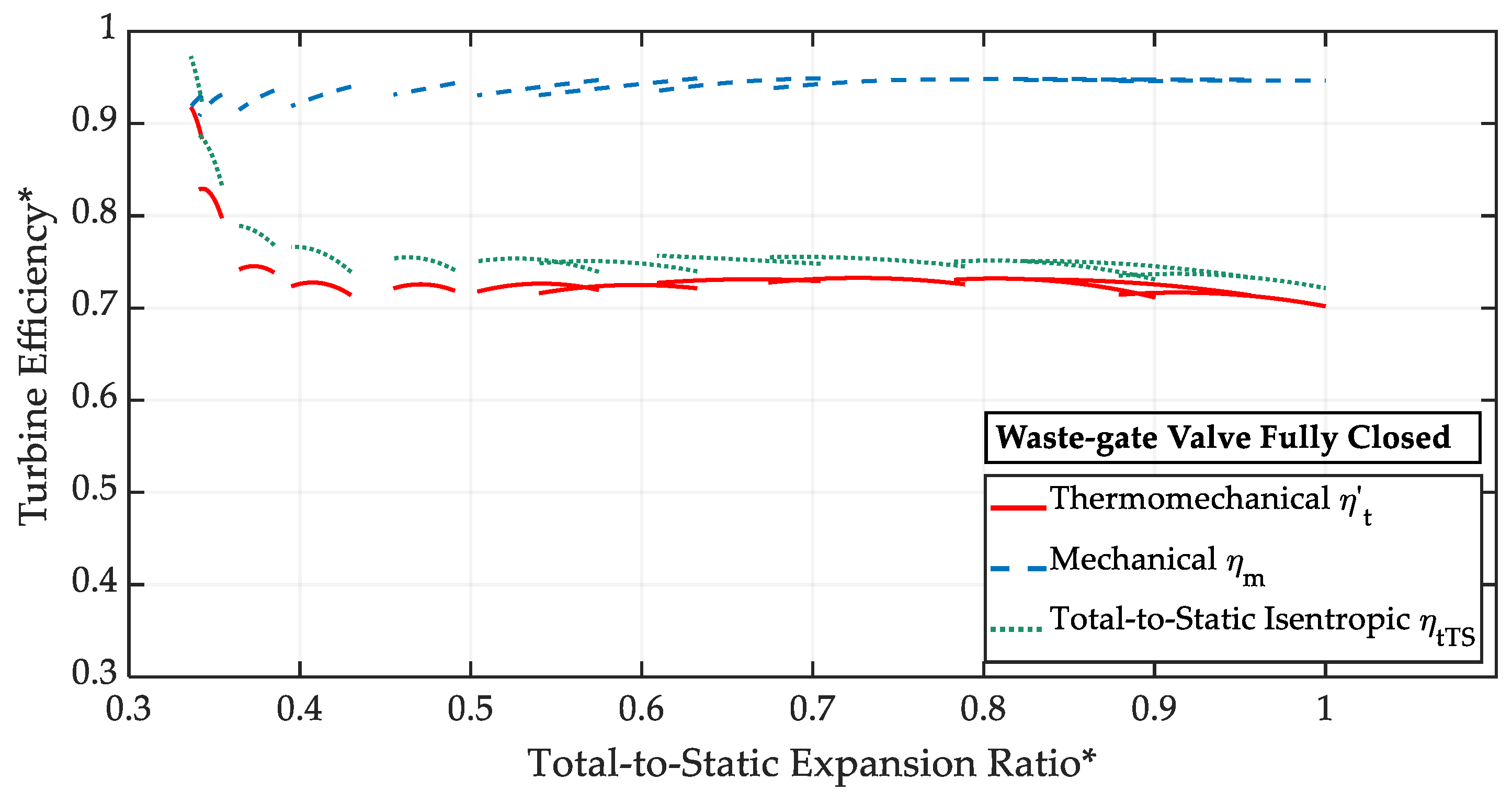
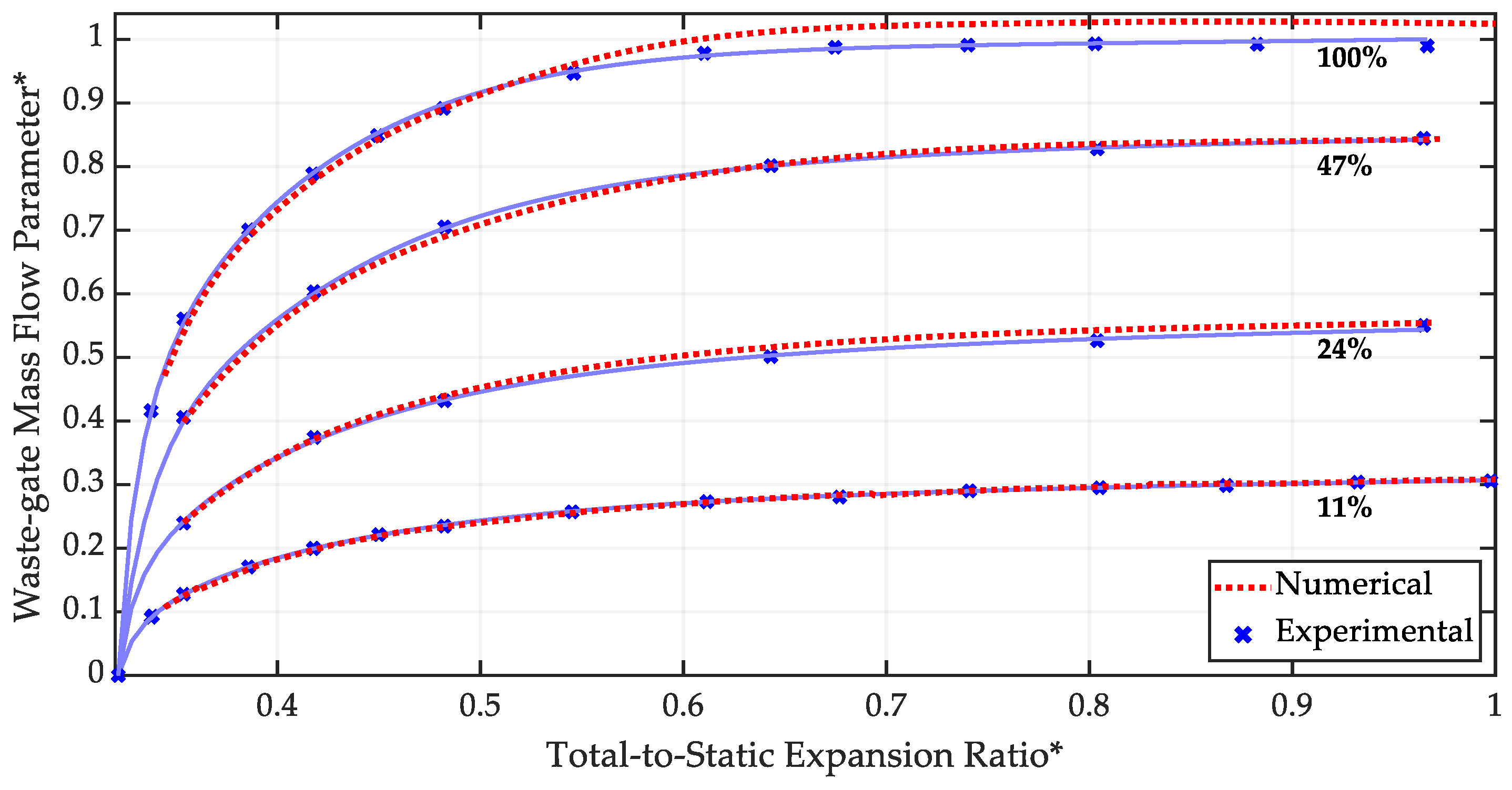
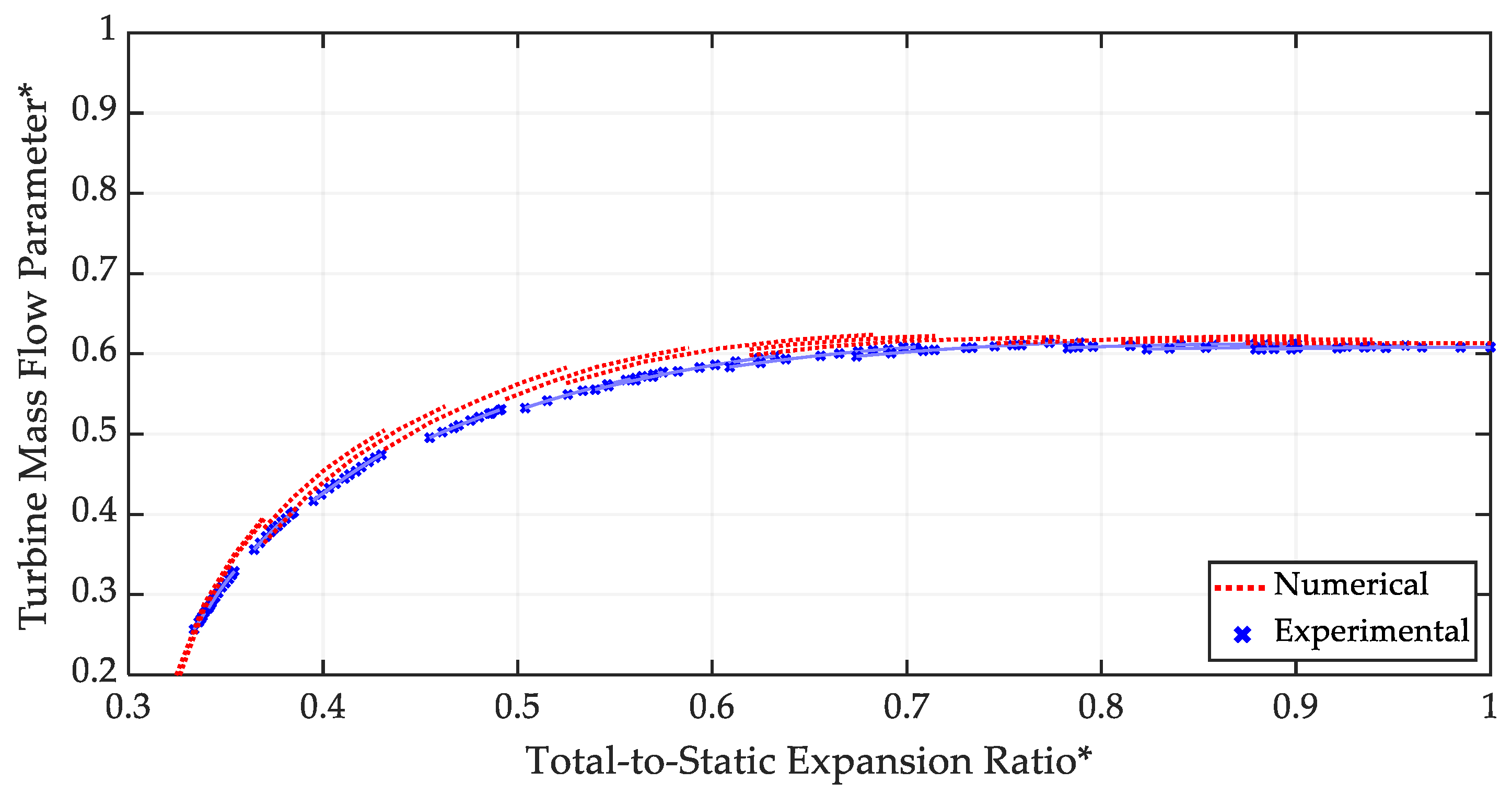
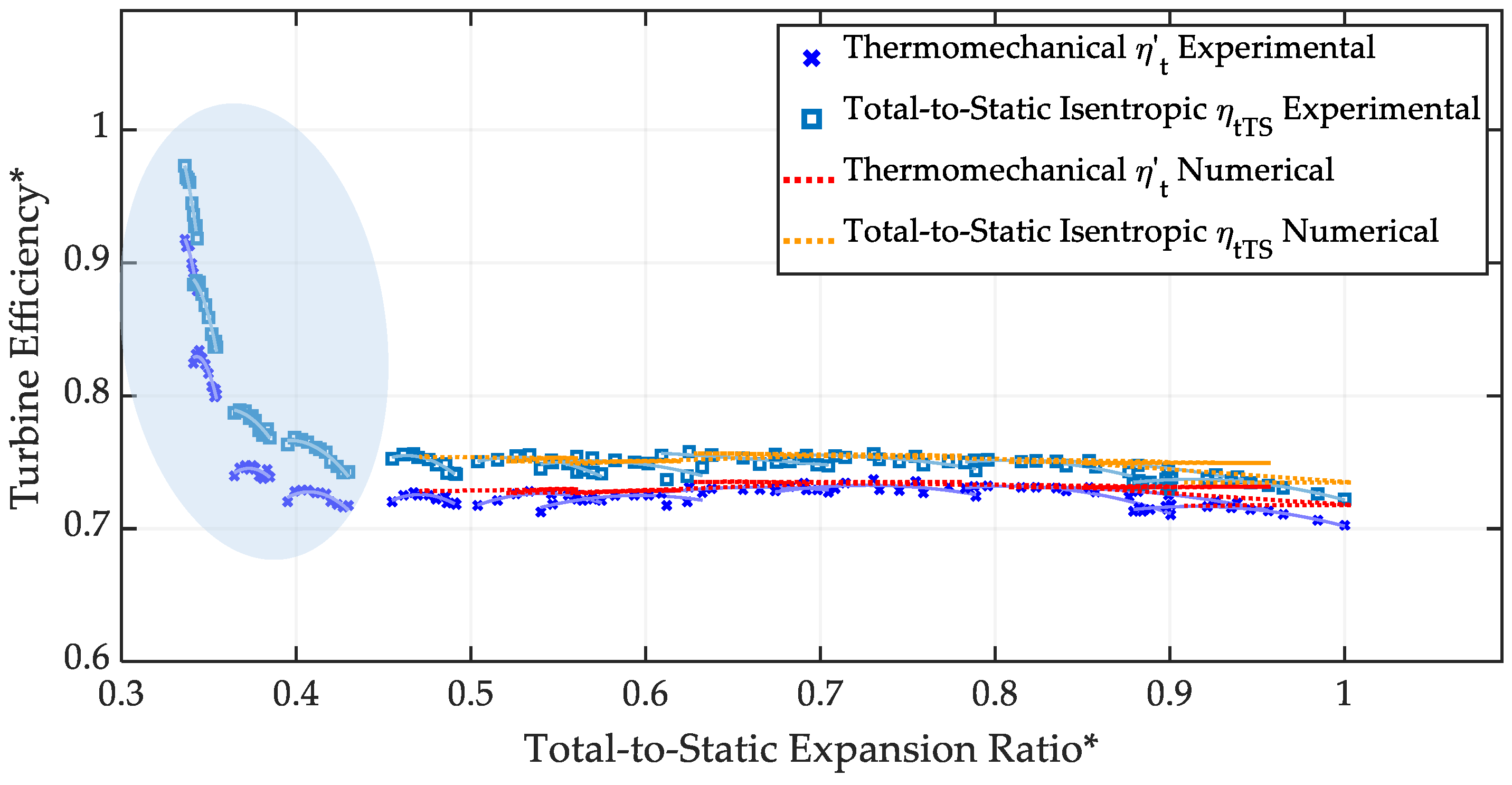
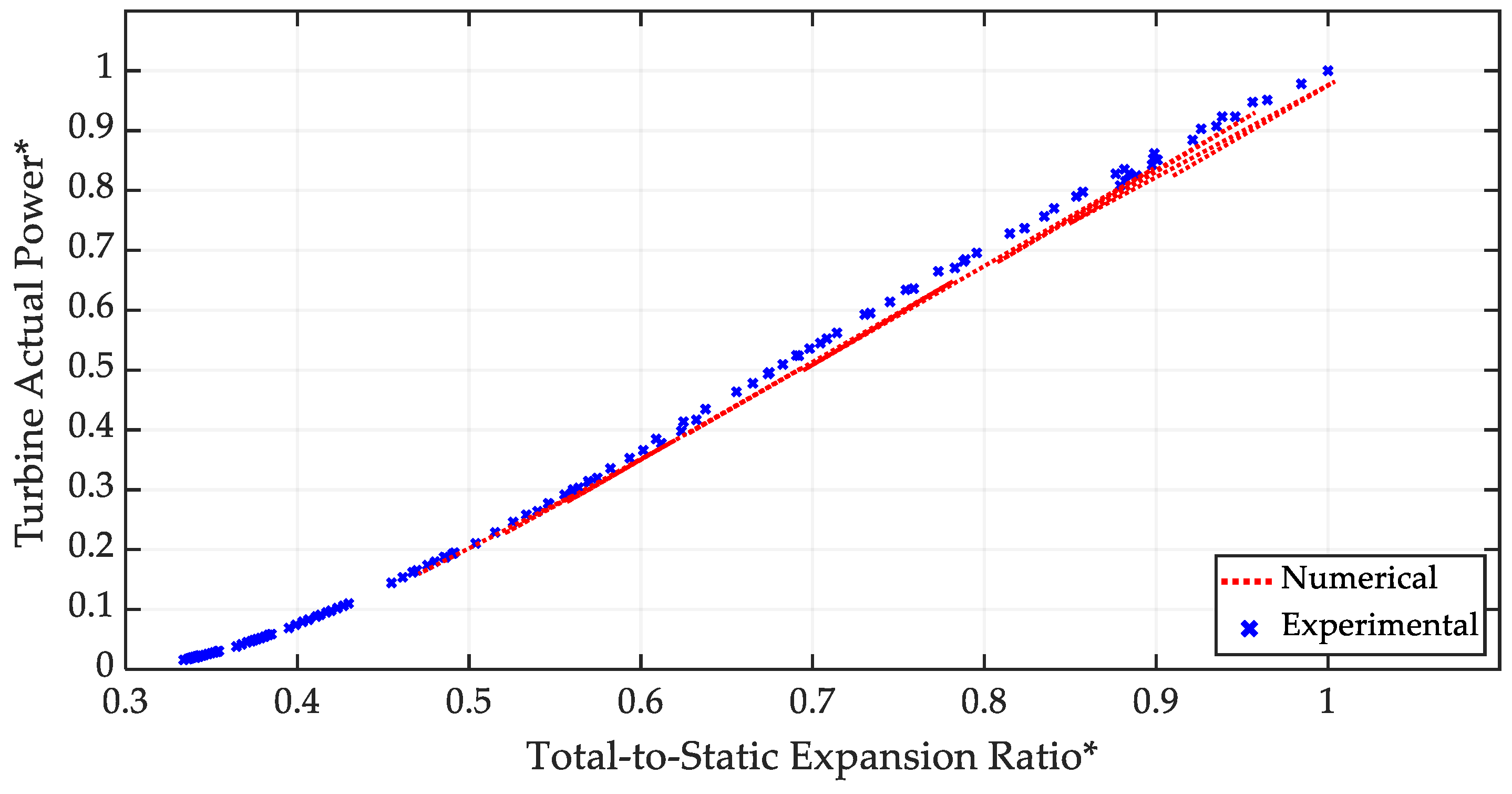

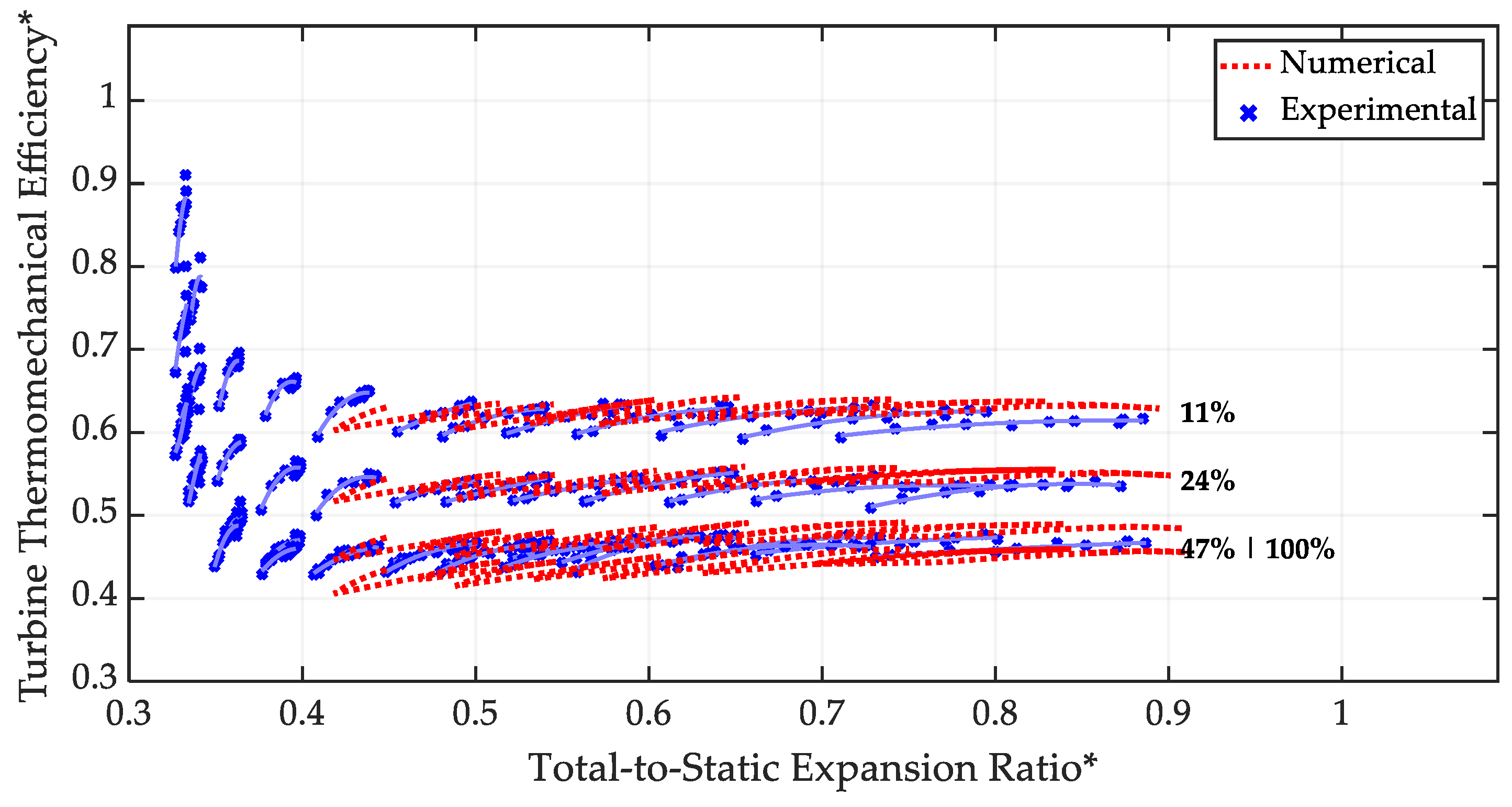

| Measured Quantities | Sensors | Uncertainty |
|---|---|---|
| Pressure | Piezoresistive transducers | ±0.10% FS |
| Temperature | Platinum resistance thermometers | ±0.15 °C and ±0.2% MV |
| Temperature | K-Type Thermocouples | ±0.5 °C |
| Mass flow rate | Thermal mass flow meter | ±0.9% MV and ±0.05% FS |
| Turbocharger rotational speed | Eddy current probe | ±0.009% FS |
| Waste-gate valve position | Rotary position sensor | ±0.5° |
| Waste-Gate Valve Opening Positions: | |||
|---|---|---|---|
| 5% | 21% | 39% | 66% |
| 11% | 24% | 47% | 79% |
| 16% | 26% | 53% | 100% (fully open) |
| At least 14 different measuring points for each waste-gate opening position | |||
| Turbine Rotational Speed Factor *: | |||
|---|---|---|---|
| Nt = 26% | Nt = 47% | Nt = 72% | Nt = 90% |
| Nt = 29% | Nt = 57% | Nt = 78% | Nt = 95% |
| Nt = 38% | Nt = 66% | Nt = 83% | Nt = 100% |
| At least 10 different measuring points for each iso speed | |||
| Turbine Rotational Speed Factor *: | |||
|---|---|---|---|
| Nt = 26% | Nt = 47% | Nt = 72% | Nt = 90% |
| Nt = 29% | Nt = 57% | Nt = 78% | Nt = 95% |
| Nt = 38% | Nt = 66% | Nt = 83% | Nt = 100% |
| Waste-gate opening positions *: | |||
| 11% | 24% | 47% | 100% |
Disclaimer/Publisher’s Note: The statements, opinions and data contained in all publications are solely those of the individual author(s) and contributor(s) and not of MDPI and/or the editor(s). MDPI and/or the editor(s) disclaim responsibility for any injury to people or property resulting from any ideas, methods, instructions or products referred to in the content. |
© 2025 by the authors. Licensee MDPI, Basel, Switzerland. This article is an open access article distributed under the terms and conditions of the Creative Commons Attribution (CC BY) license (https://creativecommons.org/licenses/by/4.0/).
Share and Cite
Cordalonga, C.; Marelli, S.; Usai, V. Performance Analysis of a Waste-Gated Turbine for Automotive Engines: An Experimental and Numerical Study. Machines 2025, 13, 54. https://doi.org/10.3390/machines13010054
Cordalonga C, Marelli S, Usai V. Performance Analysis of a Waste-Gated Turbine for Automotive Engines: An Experimental and Numerical Study. Machines. 2025; 13(1):54. https://doi.org/10.3390/machines13010054
Chicago/Turabian StyleCordalonga, Carla, Silvia Marelli, and Vittorio Usai. 2025. "Performance Analysis of a Waste-Gated Turbine for Automotive Engines: An Experimental and Numerical Study" Machines 13, no. 1: 54. https://doi.org/10.3390/machines13010054
APA StyleCordalonga, C., Marelli, S., & Usai, V. (2025). Performance Analysis of a Waste-Gated Turbine for Automotive Engines: An Experimental and Numerical Study. Machines, 13(1), 54. https://doi.org/10.3390/machines13010054






